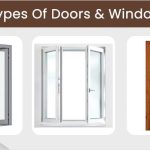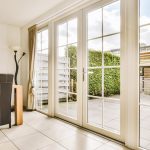Choosing the right doors and windows is an important decision when building or renovating your home. Beyond aesthetics, this choice impacts functionality, safety, maintenance needs and energy efficiency. Homeowners today evaluate modern door materials like uPVC along with conventional wood/metal options to determine the best fit.
Post your Requirement
uPVC or unplasticized polyvinyl chloride is a popular, versatile synthetic material used for window frame and door frames. uPVC doors promote weatherproofing, noise insulation, durability and cost savings in the long run. However, traditional door materials have their own charm and specific advantages.
This article compares uPVC and traditional doors across key parameters to help you choose the right option.
| Feature | uPVC Doors | Traditional Doors |
| Material | Made of unplasticized polyvinyl chloride | Various materials such as wood, metal, etc. |
| Durability | Resistant to rot, rust, and corrosion | Depends on the material; may require maintenance over time |
| Maintenance | Low maintenance; easy to clean and durable | May require regular maintenance, painting, or sealing |
| Insulation | Excellent thermal and acoustic insulation | Insulation varies based on material and quality |
| Weather Resistance | Highly resistant to weather conditions | May be susceptible to warping or damage in extreme weather |
| Security | Multi-point locking systems enhance security | Security depends on the quality of the door and locking mechanisms |
Cost | Initially higher cost but cost-effective in the long run | Initial cost may vary based on materials; ongoing maintenance costs may be higher |
| Customization | Limited color choices; may not suit all aesthetics | Wide range of design and finish options for various styles |
| Environmental Impact | Recyclable and energy-efficient production | May involve harvesting of natural resources depending on material |
| Installation | Requires professional installation | Can be installed by skilled carpenters or DIY enthusiasts |
| Longevity | Long lifespan with minimal degradation | Lifespan varies depending on material and care |
Below we have mentioned each of the comparing factor in detail:
Durability
With a lifespan over 30 years, uPVC doors are highly durable and resistant to weathering. Their robust plastic base material does not rot, warp or crack easily under exposure to rain, sun or salts. It retains form and function consistently even in coastal areas. Sturdy steel or aluminum reinforcements within frames prevent sagging.
Wooden doors, when made from good quality hardwoods like teak, oak or mahogany, also have inherently high durability, lasting over two decades. However, lower priced softwood, plywood or veneered doors may warp or discolor faster. Frequent polishing and touch up is needed to maintain wooden doors.
Metallic door frames usually involve steel, aluminum or iron which are intrinsically corrosion resistant. But surface paint may thin out faster. Hollow metal doors tend to be less sturdy than solid wood or uPVC but still deliver reasonable life with care.
Overall, uPVC doors deliver exceptionally enduring performance, retaining visual appeal and integrity for decades with minimal maintenance against harsh weather.
Insulation
Doors serve as insulation barriers against outside temperatures, noise, dust and pests. uPVC doors with their fused frames, tight seals and multi air-chamber structure offer high insulation. The inherent air pockets also enhance acoustic dampening from outside traffic sounds.
Wood has moderate insulating capacity depending on density and thickness. But additional wool insulation and perimeter sealing needs to be installed for desired noise/temperature insulation especially in exterior doors.
Metal door frames conduct more heat/cold by default. Hence additional weatherstripping inserts are incorporated to block out external sounds/temperatures.
uPVC doors hence provide better heat and sound insulation through built-in air pockets/seals compared to traditional doors needing secondary insulation applications.
Weatherproofing
With silicone gaskets, internal drainage channels and joints fused to frames rather than glued, uPVC doors are fully weatherproof. They prevent seepage of water, moisture or air drafts inside homes irrespective of rainfall or storms. Their non-corroding and non-rusting properties maintain watertight performance over years without seasonal reapplications of polish.
Untreated wooden doors soak in water and moisture which leads to rotting, warping and fungal decay with time. They need re-varnishing before monsoons to retain some water resistance each year. For outdoor use, waterproof plywood with lamination is preferred but also needs periodic reproofing.
Metallic doors unless accessorized with buffers swell or contract excessively under humidity. Hollow metal doors allow moisture/water seepage with time. Hence additional seals are applied over standard paint for weatherability. Still the protective coatings require update every few years.
uPVC is inherently weather-resistant owing to its non-porous, dense formulation retaining stability across climate swings. This durability against outdoor exposure gives uPVC doors substantial functional edge.
Maintenance
uPVC doors are ultra-low maintenance through years of use even in coastal regions. An occasional wipe down coupled with hinge lubrication half-yearly suffices with no need for seasonal refinishing. Their color retention is also excellent with surface shine intact for decades due to resistance.
Wooden doors need intensive yearly upkeep like polishing, varnishing, termite treatments to uphold appearance, prevent infections and avert moisture damage. Any cracks or chips also require prompt filling and painting touch-ups. Teak oil coats additionally enhance waterproofing but demand repetition.
Metal doors similarly need re-coating of protective paints, sealants or galvanization after few years to prevent corrosion and rusting. Seasonal cleaning of condensed moisture and limescale deposits through the year is also advised to expand lifespan.
uPVC is hassle-free on maintenance aspects owing to its inherent durability and chemical stability requiring no reproofing or refinishing for maintaining quality.
Safety and Security
Reinforced with steel or aluminum bars, uPVC doors assure burglary protection and intrusion resistance. The integrated metal bars make breaking in extremely tough even through force. For high security needs, multi-point locking mechanisms and hook latches easily integrate with uPVC frames. Being non-combustible, uPVC doors also act as fire retardants significantly slowing flame spread.
While wooden doors often feature decorative grills or glass for aesthetics, these weaken safety. Unless metal sheeting runs through core wooden doors remain vulnerable to break-ins. For bulletproofing, only high-density hardwoods work but need heavy customization losing visual appeal. As combustible material, untreated wood aggravates fire risks lacking inherent fire resistance.
Metal doors offer kick-proof, drill-proof and bullet-resistant options through thicker gauge steel and proprietary alloys but at exponentially higher budgets. Specialized coatings for fire rating/alarm systems also apply for safety though standard metal doors lack fire containment abilities.
uPVC door’s strong, long-lasting and versatile material structure makes it suitable for the widest range of safety and security needs at reasonable pricing.
Customization Scope
uPVC doors lend themselves well to customized sizing, finishes and fitting choices. Being factory manufactured, door panels can be molded as per measurements including specialized shapes like arched doorways. Rich woodgrain textures get embossed through high-definition printing for aesthetics while retaining uPVC advantages.
For custom carvings, cutwork, stained glass, structural changes however wood/metal is better suited. But their customization area is limited for ornamentation alone not enhancing functionality or weatherability. Unique shapes also depend on carpentry skills pushing budgets higher.
uPVC offers moderate design flexibility largely concentrating on enhancing door performance through glazing, ventilation and hardware upgrades rather than just visual factors.
Energy Efficiency
With multi-chambered bodies curtailing heat/cold conduction and integral seals blocking drafts, uPVC doors promote energy efficiency. Their low U-value indicates effective insulation preventing indoor heat from escaping out during winters and vice versa in summers. This reduces electricity usage for heating/cooling ensuring green footprint.
Unless specifically rated, wooden doors lack reliable thermal performance metrics as density, moisture content and fitting gaps create variables. Only precision engineered doors guarantee energy efficiency often at exponentially higher price points.
Metal doors similarly depend on separately installed buffers and air pockets to prevent heat/cold transfer lacking innate insulation. Thermal bridging through screws/hinges also reduces ratings without comprehensive edge guards.
uPVC doors hence distinctly lead controlling energy wastage in homes through inherent insulation plus seals outperforming traditional doors on this sustainability parameter.
Value for Money
Owing to their longevity spanning decades, low maintenance needs and built-in insulation features, uPVC doors make high value investments. The money spent gets returned manifold over years of reliable functioning with least upkeep among all door variants. DIY installations further economize cost.
Wooden doors localized availability keeps purchase rates reasonable but continual polishing, termite treatments and humidity damage repairs tally up lifelong making them sink investments. Custom woodwork for ornamentation, fire ratings or security comes at steep price premiums too.
Metal doors affordability ranks only next to basic wooden variants and much lesser than uPVC. But their demerits like higher operational costs for heating/cooling from poor insulation couples with recurrent paint/sealant redos for corrosion resistance making them drain expenses lifelong.
uPVC doors hence rank as most economical choice matching durability with design flexibility and ease of use at reasonable capital outlay reclaiming investments through longevity and reliability.
Conclusion
Evaluating door options on metrics spanning functionality, usability, design adaptability, safety, sustainability and value paints a clear picture. uPVC doors outshine traditional alternatives on most homeowner requirements – whether strength, weatherproofing, insulation, customization, energy-efficiency or long-term returns on investment.
While wood still makes sense for bespoke ornamental entryways, its practical utility lags on exterior usage facing weatherwear issues. Metal doors serve specific applications like industrial/commercial which justify higher security spends that residential usage may not require. Weighing merits against intended area of adoption helps determine their selective suitability.
But for holistic home usage wanting optimal fusion of durability, insulation, customizability and lifecycle value beyond sheer aesthetic appeal, uPVC doors deliver performance at price points matching conventional options. Their sustainability quotients also tally closely with the greener building movement catching on among conscientious architects and homeowners today.
uPVC doors hence make smart investments for contemporary households through their versatile advantages balancing functionality and form economically. Being low maintenance and inherently hardy, they ease ownership hassles through uncomplicated operation year after year. For new age door decisions, uPVC doors present that optimal blend of efficiency, economics and eco-friendliness raising the bar on building standards overall.


















Post A Comment